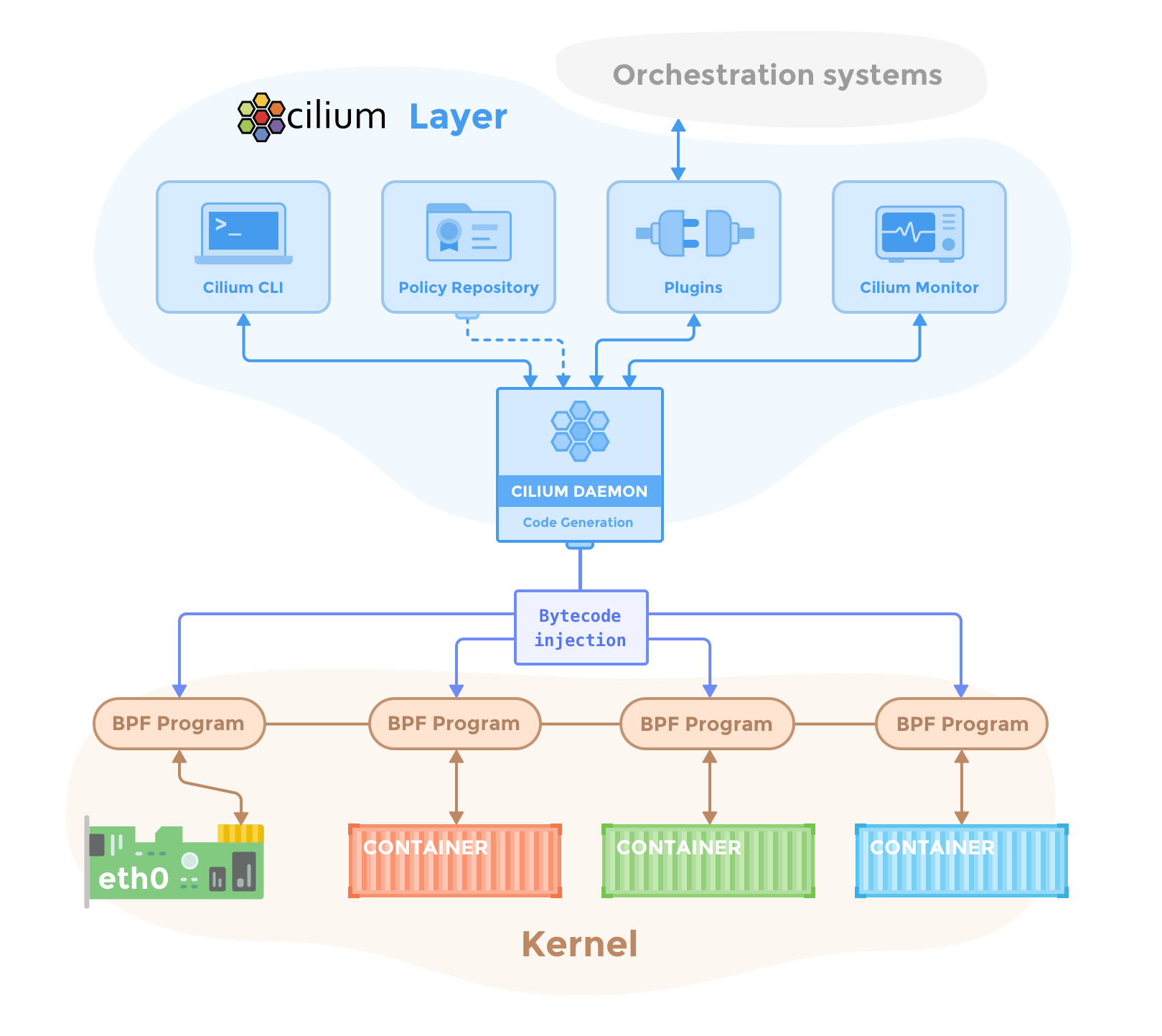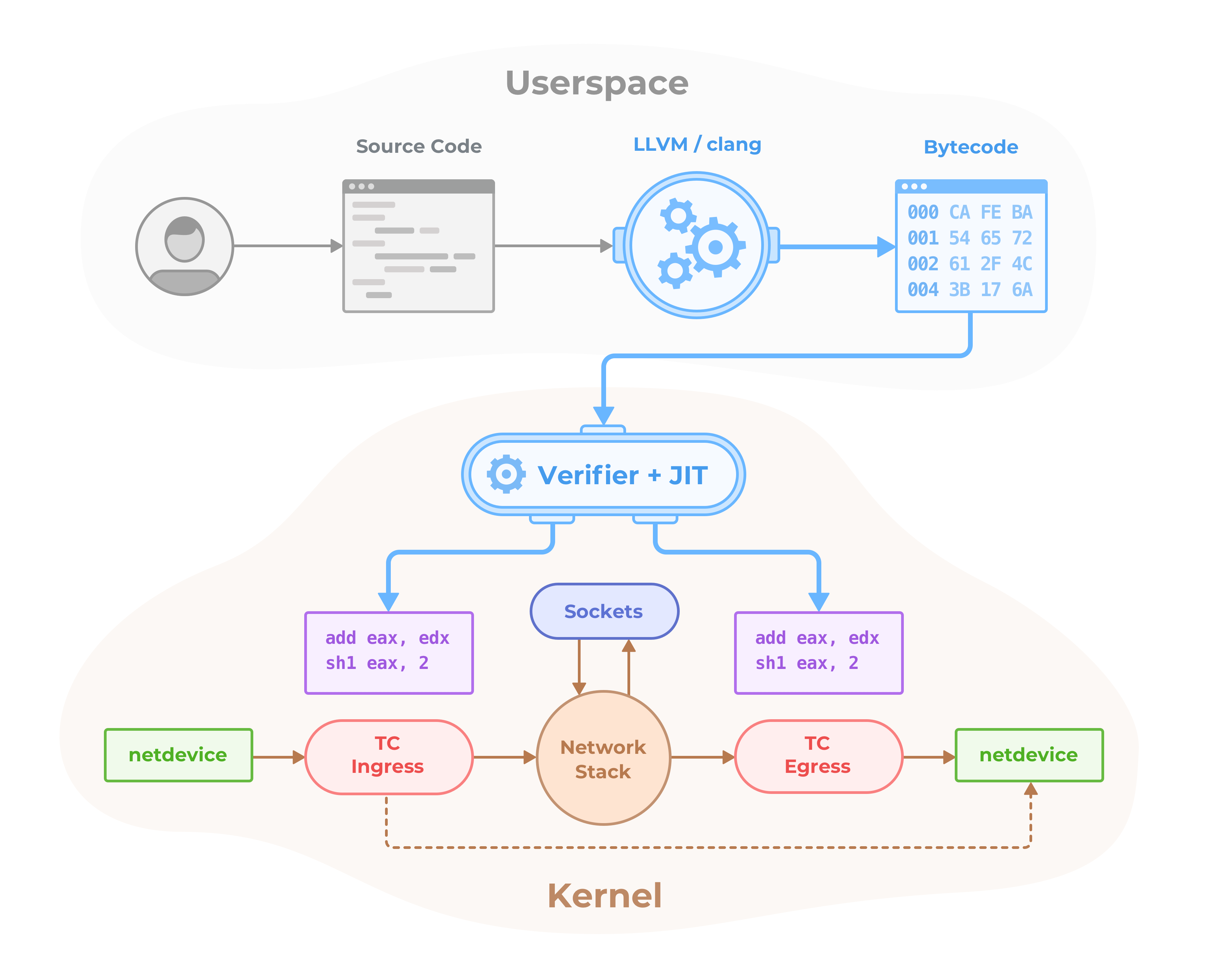Cilium is open source software for providing and transparently securing network connectivity and loadbalancing between application workloads such as application containers or processes. Cilium operates at Layer 3/4 to provide traditional networking and security services as well as Layer 7 to protect and secure use of modern application protocols such as HTTP, gRPC and Kafka. Cilium is integrated into common orchestration frameworks such as Kubernetes and Mesos.
A new Linux kernel technology called BPF is at the foundation of Cilium. It supports dynamic insertion of BPF bytecode into the Linux kernel at various integration points such as: network IO, application sockets, and tracepoints to implement security, networking and visibility logic. BPF is highly efficient and flexible. To learn more about BPF, read more in our extensive BPF and XDP Reference Guide.
Stable Releases
The Cilium community maintains minor stable releases for the last three major Cilium versions. Older Cilium stable versions from major releases prior to that are considered EOL. Listed below are the actively maintained release branches along with their latest minor release, corresponding image pull tags and their release notes:
| v1.6 | 2019-10-08 | docker.io/cilium/cilium:v1.6.3 |
Release Notes | General Announcement |
| v1.5 | 2019-10-08 | docker.io/cilium/cilium:v1.5.9 |
Release Notes | General Announcement |
| v1.4 | 2019-10-08 | docker.io/cilium/cilium:v1.4.9 |
Release Notes | General Announcement |
Functionality Overview
Protect and secure APIs transparently
Ability to secure modern application protocols such as REST/HTTP, gRPC and Kafka. Traditional firewalls operates at Layer 3 and 4. A protocol running on a particular port is either completely trusted or blocked entirely. Cilium provides the ability to filter on individual application protocol requests such as:
- Allow all HTTP requests with method
GETand path/public/.*. Deny all other requests. - Allow
service1to produce on Kafka topictopic1andservice2to consume ontopic1. Reject all other Kafka messages. - Require the HTTP header
X-Token: [0-9]+to be present in all REST calls.
See the section Layer 7 Policy in our documentation for the latest list of supported protocols and examples on how to use it.
Secure service to service communication based on identities
Modern distributed applications rely on technologies such as application containers to facilitate agility in deployment and scale out on demand. This results in a large number of application containers to be started in a short period of time. Typical container firewalls secure workloads by filtering on source IP addresses and destination ports. This concept requires the firewalls on all servers to be manipulated whenever a container is started anywhere in the cluster.
In order to avoid this situation which limits scale, Cilium assigns a security identity to groups of application containers which share identical security policies. The identity is then associated with all network packets emitted by the application containers, allowing to validate the identity at the receiving node. Security identity management is performed using a key-value store.
Secure access to and from external services
Label based security is the tool of choice for cluster internal access control. In order to secure access to and from external services, traditional CIDR based security policies for both ingress and egress are supported. This allows to limit access to and from application containers to particular IP ranges.
Simple Networking
A simple flat Layer 3 network with the ability to span multiple clusters connects all application containers. IP allocation is kept simple by using host scope allocators. This means that each host can allocate IPs without any coordination between hosts.
The following multi node networking models are supported:
Overlay: Encapsulation-based virtual network spanning all hosts. Currently VXLAN and Geneve are baked in but all encapsulation formats supported by Linux can be enabled.
When to use this mode: This mode has minimal infrastructure and integration requirements. It works on almost any network infrastructure as the only requirement is IP connectivity between hosts which is typically already given.
Native Routing: Use of the regular routing table of the Linux host. The network is required to be capable to route the IP addresses of the application containers.
When to use this mode: This mode is for advanced users and requires some awareness of the underlying networking infrastructure. This mode works well with:
- Native IPv6 networks
- In conjunction with cloud network routers
- If you are already running routing daemons
Load balancing
Distributed load balancing for traffic between application containers and to external services. The loadbalancing is implemented using BPF using efficient hashtables allowing for almost unlimited scale and supports direct server return (DSR) if the loadbalancing operation is not performed on the source host. Note: load balancing requires connection tracking to be enabled. This is the default.
Monitoring and Troubleshooting
The ability to gain visibility and to troubleshoot issues is fundamental to the
operation of any distributed system. While we learned to love tools like
tcpdump and ping and while they will always find a special place in our
hearts, we strive to provide better tooling for troubleshooting. This includes
tooling to provide:
- Event monitoring with metadata: When a packet is dropped, the tool doesn't just report the source and destination IP of the packet, the tool provides the full label information of both the sender and receiver among a lot of other information.
- Policy decision tracing: Why is a packet being dropped or a request rejected. The policy tracing framework allows to trace the policy decision process for both, running workloads and based on arbitrary label definitions.
- Metrics export via Prometheus: Key metrics are exported via Prometheus for integration with your existing dashboards.
Integrations
- Network plugin integrations: CNI, libnetwork
- Container runtime events: containerd
- Kubernetes: NetworkPolicy, Labels, Ingress, Service
Getting Started
- Why Cilium?
- Getting Started
- Architecture and Concepts
- Installing Cilium
- Frequently Asked Questions
- Contributing
What is eBPF and XDP?
Berkeley Packet Filter (BPF) is a Linux kernel bytecode interpreter originally introduced to filter network packets, e.g. for tcpdump and socket filters. The BPF instruction set and surrounding architecture has recently been significantly reworked with additional data structures such as hash tables and arrays for keeping state as well as additional actions to support packet mangling, forwarding, encapsulation, etc. Furthermore, a compiler back end for LLVM allows for programs to be written in C and compiled into BPF instructions. An in-kernel verifier ensures that BPF programs are safe to run and a JIT compiler converts the BPF bytecode to CPU architecture specific instructions for native execution efficiency. BPF programs can be run at various hooking points in the kernel such as for incoming packets, outgoing packets, system calls, kprobes, uprobes, tracepoints, etc.
BPF continues to evolve and gain additional capabilities with each new Linux release. Cilium leverages BPF to perform core data path filtering, mangling, monitoring and redirection, and requires BPF capabilities that are in any Linux kernel version 4.8.0 or newer (the latest current stable Linux kernel is 4.14.x).
Many Linux distributions including CoreOS, Debian, Docker's LinuxKit, Fedora,
openSUSE and Ubuntu already ship kernel versions >= 4.8.x. You can check your Linux
kernel version by running uname -a. If you are not yet running a recent
enough kernel, check the Documentation of your Linux distribution on how to run
Linux kernel 4.9.x or later.
To read up on the necessary kernel versions to run the BPF runtime, see the section Prerequisites.
XDP is a further step in evolution and enables to run a specific flavor of BPF programs from the network driver with direct access to the packet's DMA buffer. This is, by definition, the earliest possible point in the software stack, where programs can be attached to in order to allow for a programmable, high performance packet processor in the Linux kernel networking data path.
Further information about BPF and XDP targeted for developers can be found in the BPF and XDP Reference Guide.
To know more about Cilium, it's extensions and use cases around Cilium and BPF take a look at Further Readings section.
Community
Slack
Join the Cilium Slack channel to chat with Cilium developers and other Cilium users. This is a good place to learn about Cilium, ask questions, and share your experiences.
Special Interest Groups (SIG)
See Special Interest groups for a list of all SIGs and their meeting times.
Weekly Developer meeting
- The developer community is hanging out on zoom on a weekly basis to chat. Everybody is welcome.
- Weekly, Monday, 9:00 am PT, 12:00 pm (noon) ET, 6:00 pm CEST
- Join zoom
License
The cilium user space components are licensed under the Apache License, Version 2.0. The BPF code templates are licensed under the General Public License, Version 2.0.





